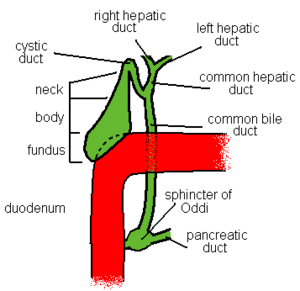Biliary system
Structure and Function
Structure
Separated into the fundus, the body and the neck. Its basically a pear shaped sac that sits on the underside of the liver. It drains into the cystic duct, which joins with the common hepatic duct to form the common bile duct.
Anterior is the anterior abdominal wall and the inferior surface of the liver. Posterior is the transverse colon and the first and second parts of the duodenum.
Functions
- Concentrates bile
- Selectively absorbs bile salts
- Keeps the bile acidic
- Excretes cholesterol
- Secretes mucus
When digestion is not happening, the sphincter of Oddi at the bottom of the common bile duct (at the join of the pancreatic duct, at the ampulla of Vater, just before it drains into the duodenum) remains closed, and so bile accumulates and is stored in the bile duct.
Bile is concentrated by the absorption of water, Na+ and Cl- into the walls of the mucosa. Upto 12 hours of bile secretion is stored in concentrated form. When fats enter the duodenum, it releases the hormone cholecystokinin which enters the blood and stimulates contraction of the gall bladder and relaxation of the circular muscle at the sphnincter of Oddi.
Arterial and Venous supply
The gall bladder is supplied by the cystic artery, which branches off the right hepatic, and drains into the portal vein. A few very small arteries and veins also run directly between liver and gall bladder.
Nervous Supply
Fibres from the celiac plexus which contains vagal sympathetic and parasympathetic fibres.
Lymph
There is a cystic node at the neck, that drains to the hepatic nodes and then on to the celiac nodes.
Histology
The mucosal membrane is thrown into permanent folds that join to each other, giving a honeycomb surface appearance. The columnar cells on the epithelium also have microvilli. This is to aid it in the absorption and secretion functions it performs.
Clinical Conditions
Gallstones
Risk factors
The Five Fs: Fat Female Forty Fair Fertile
The majority are asymptomatic, but it presents when there is bile duct obstruction.
Bile duct obstruction
Pain caused by the temporary obstruction of the cystic or common bile duct by a stone. Prevents with an acute, severe and slowly worsening pain. Initial pain is in the epigastrium/upper right quadrant. There may be radiation to the right shoulder if the diaphragm is irritated, since the nerves C3 and C4 supply the diaphragm and pass over the shoulder.
Jaundice is common and fever may also be present in severe cases that are progressing towards septicaemia. This is the one you want for Murphy's sign, a pain on inspiration
Treatment
Surgery to remove the stones, or with smaller stones using ultrasound to break them up.
Adenocarcinoma of the gall bladder
Pretty rare. Poor survival rate due to very early spread to liver and adjacent biliary tract – 5% last 5 years. No chemo has yet been found to be effective in this type of cancer either, so all in all, not a good one - don't get it!
